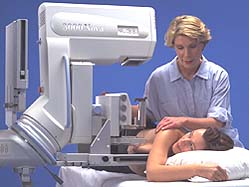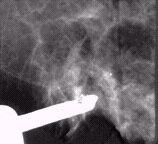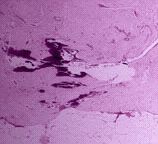A breast biopsy involves removing a sample of breast tissue to determine whether it is cancerous or benign (non-cancerous). While physical breast exam, mammography,ultrasound, and other breast imaging methods can help detect a breast abnormality, biopsy followed by pathological (microscopic) analysis is the only definitive way to determine if cancer is present.

Image courtesy of Siemens Medical.
Once a sample of breast tissue has been removed by the radiologist or surgeon, it is sent to the laboratory for microscopic examination by a pathologist. A clinical pathologist is a special physician who performs laboratory analyses of tissues to determine their type. Learn more about the breast pathology report.

This mammogram image is used for breast biopsy guidance and shows that the suction assisted biopsy probe (Biopsys Mammotome) is positioned in the breast and aligned with calcifications (white specks above need opening)

This pathology image of a breast biopsy specimen shows Hyalinized Calcified Fibroadenoma (courtesy Biopsys)
It is estimated that over 48 million mammograms are performed each year and that less than one million of them (less than 5%) are recalled to undergo a biopsy (in some instances the number of cases requiring biopsy can be as low as 2%, depending on population demographics and methods of care). Fortunately, 65% to 80% of breast biopsies result in benign (non-cancerous) diagnosis.
However, if cancer is found to be present after pathological analysis of the biopsy sample(s), it is critical that the type and stage of the cancer be identified as soon as possible. Generally, the earlier breast cancer is diagnosed, the greater a patient's chances of survival. Overview of the breast cancer diagnostic process.
There are several different methods of breast biopsy, many of which are discussed in detail herein. These types include:
- Fine needle aspiration (FNA)
- Core needle biopsy
- Vacuum-assisted biopsy (Mammotome or MIBB)
- Large core surgical (ABBI)
- Open surgical (excisional or incisional)
One method of biopsy will likely be most favorable depending on a number of factors, including how suspicious the abnormality appears; the size, shape, and location of the abnormality; the number of abnormalities present; the patient's medical history; the patient's preference; the training of the radiologist or surgeon who is performing the biopsy; and the breast imaging center or surgical center where the biopsy is performed.
The side effects and risks of biopsy vary depending on the type of biopsy performed. Women are strongly encouraged to discuss the advantages and disadvantages of the different biopsy methods with their physician(s) prior to undergoing the procedure.



